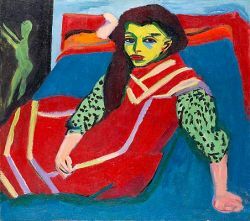History of art is an area of study that addresses the various artistic manifestations produced by the man with the aesthetic or communicative purpose to express ideas, emotions and ways of seeing the world.
It follows the development of human history, relating to the most varied culture existing peoples in the world, seeking to understand the manifestations that were and are being carried out until today.
The history of art, as well as historical facts, help to compose the history of societies. Many researchers from different areas try to unravel the origins of humanity and among so much research, the conclusion is that the appearance of man is directly associated with the appearance of symbolic forms, which help to build possible testimonies about the origin and evolution of the human being.
In this way, art history is generally organized into periods that accompany the development of civilizations and is a continuous process, which never comes to an end, as it is being lived each day.
Periods of art history
The periods are equivalent to a kind of art history timeline, or to a chronological order of the path of humanity. We can then find artistic manifestations present in Prehistory, Antiquity and the Middle Ages, Modern and in the 20th century.
Art in Prehistory
Prehistory was the first period of human evolution to leave traces of humanity's earliest symbolic forms.
The pioneering forms of artistic expression of this time are the cave paintings, where the men of that time left them drawn on the walls of the caves where they lived, their way of living and seeing the world and through these rustic paintings, he recorded their beliefs and the way they perceived the nature. The various places where these paintings were discovered are called archaeological sites.
Other elements that also reveal the way of life of prehistoric man, and that can be considered important historical remains, are the sculptures and artifacts made in bone, stone or wood.
art in antiquity
This period was marked by the discovery of writing and the Egyptians were the most influenced by this evolution.
The creation of hieroglyphic symbols and signs are the highlights of this era. Their abilities were manifested through the tombs of pharaohs, statues of deities, and other artifacts from their daily lives.
The Greeks also developed the aptitude through paintings, monuments and buildings, which had man as their main reference, as he was considered the center of perfection.
art in the middle ages
This period is marked by religious influence. The Celtic, Gothic and Roman artistic expressions stand out.
The Roman people also played an important role in the artistic activities of the time, with famous constructions that impacted the architecture and also through paleochristian art, which was based on the teachings of Christ and through art Byzantine.
art in the modern age
The Modern Age was marked by a period of intense expansion, due to geographical discoveries. The artistic works of the time were mainly based on nature. There were great highlights:
Rebirth – Greco-Roman art reappeared and painting stood out.
Baroque – Valued feelings and emotions. The style was influenced by the Protestant Reformation and Counter-Reformation.
Rococo – Stage of valuing the decorative features. The highlight was the decoration and ornamentation of the environments.
Art in the Contemporary Age
Also called contemporary art, this period was one of great conflicts, such as the French Revolution, the First and Second World Wars, and the Cold War.
The artistic expressions of the time were manifested through movements such as neoclassicism, romanticism, realism and impressionism, which revolutionized 20th century art.
20th century art
This period is marked by the emergence of major artistic trends such as expressionism, fauvism, Cubism, Futurism, Abstractionism, Dadaism and Surrealism, movements that represent a lot to the world of Art. During each of these expressions, great artists surprised and notorious works were created.
know more about expressionism, characteristics of expressionism and The Types of Art.
History of art in Brazil
The history of art in Brazil arose from a mixture of other styles and dates back to the period of Prehistory, with several archaeological sites spread throughout the territory. Indigenous art also stands out, which has been noticed since the time of the discovery of Brazil, with artistic expressions very characteristic of the tribes, such as dances, rituals, objects, etc.
The arrival of the Portuguese and Europeans also brought with them great changes, such as the Baroque style, linked to Catholicism.
Academic painting, also in the 19th century, in Brazilian art, portrays the classical richness, and an ideal beauty standard was reflected (standards proposed by the Academy of Fine Arts).
At the beginning of the 20th century, we witnessed Brazilian Modernism, initially marked by the Week of Modern Art. And, before that, Expressionism began to arrive in Brazil and make history with Lasar Segall (1891-1957), who contributed to Modernism.
See also the meanings of art and Art Nouveau.


